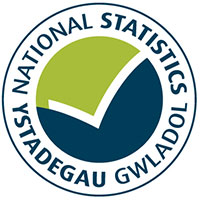Data on ethnicity, disability status, marital status and religion produced from the Annual Population Survey for 2015 to 2017.
This is not the latest release in the series: Equality and diversity statistics
Main points
Ethnicity
- 95.6% of the population of Wales described their ethnic group as White. This varied by region from 97.8% of the population in North Wales to 94.3% in South East Wales.
- 4.4% of the population described themselves as Asian, Black, ‘Mixed/Multiple ethnic group’ or ‘Other ethnic group’. Those describing their ethnic group as Asian were the second largest ethnic group in Wales (2.1% of the population).
Disability
- A fifth of the population aged 16 to 64 identified as disabled. However, a higher proportion of women than men identified as disabled (23.0% compared with 18.8%). The proportion of people identifying as disabled increased by age group for both sexes.
Religion
- Over half of the population of Wales identified as Christian (52.8%). Whereas 42.7% of the population stated they had no religion. However, these figures varied by region. In North Wales, 60.0% of the population identified as Christian and 36.9% stated they had no religion. This compares with 48.6% and 46.1% of people in South East Wales respectively.
- Nearly 50,000 people (1.6% of the population) identified as Muslim. Over two thirds (69%) of the Muslim population in Wales were domiciled in South East Wales.
- A higher proportion of women than men identified as having a religion (61% compared with 53%) and the proportion of people identifying as having a religion increased by age group. This contrasts with the proportion of people stating they had no religion which notably decreased as age increased.
Marital status
- Nearly half of the population aged 16 and over in Wales were married or in a civil partnership whereas a third of the population were single. A slightly lower proportion of the population of South East Wales were married (47.3%) compared with Mid/West Wales and North Wales (49.0% and 50.1% respectively).
- A higher proportion of men were married than women (50.2% compared with 46.7%). However, a higher proportion of women were widowed or surviving a civil partnership than men (9.9% compared with 3.8%).
Further information
The Annual Population Survey (APS) samples around 18,000 households in Wales every year. However, the sample sizes for people with ‘protected characteristics’ (as specified in the Equality Act 2010) can be relatively small. Therefore, to improve the evidence base on people with ‘protected characteristics’, more detailed analysis has been produced from a pooled dataset which combines 3 years of APS data. This analysis can be found on our StatsWales website (see ‘Data’ tab below).

